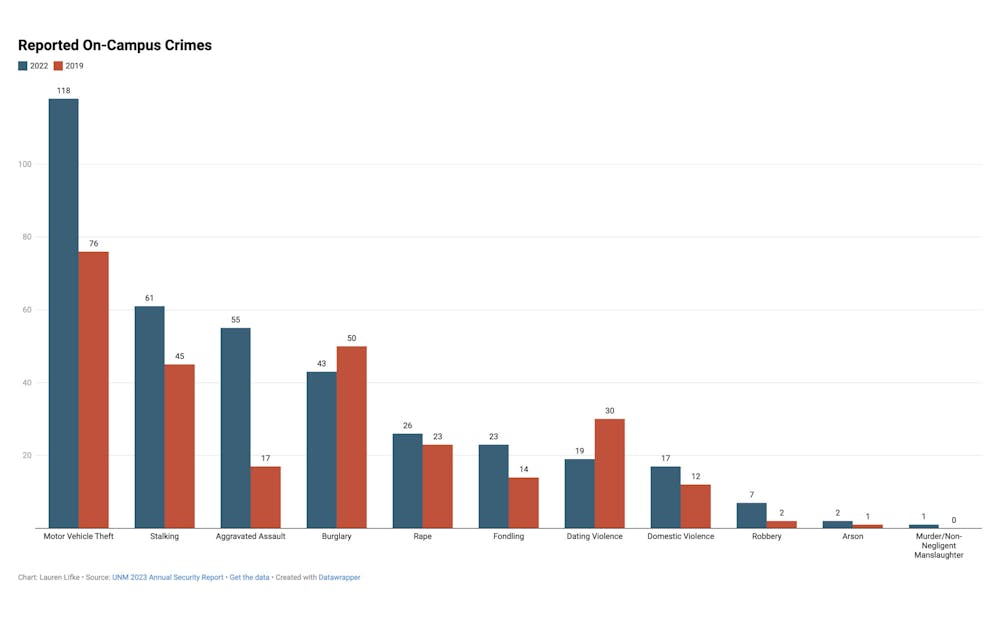The University of New Mexico released its Annual Security & Fire Safety Report (ASFSR) on Friday, Sept. 30. It includes 609 Clery crimes last year. There is no guarantee this number reflects all campus crime data.
Pre-pandemic in 2019, there were 588 crimes. Hate crimes rose to 34 reported in 2022 compared to a reported two in 2019. 23 of these were thefts related to sexual orientation, according to the report.
For the annual report, Clery coordinator Adrienne Helms is required to reach out to local law enforcement agencies — including but not limited to the Albuquerque Police Department — to request data on crimes that occur in UNM’s Clery geography but outside of UNM Police Department jurisdiction, she said. However, outside agencies are not required to provide any data.
“The Clery Coordinator relies on the information obtained from (local law enforcement) sources but is not responsible if the information provided is inaccurate or omitted altogether,” the 2023 ASFSR reads.
It is difficult to acquire crime statistics from APD in part because of their high call volume and the lack of resources to examine the location of each report, Helms said.
The ASFSR contains all Clery crimes reported to UNM Campus Security Authorities (CSA) each calendar year, regardless of investigation or court status, according to the report. CSAs include campus police, security personnel, officials with significant responsibility for student and campus activity and others defined in University policy.
Clery crimes must fall in one of four categories: primary offenses (including sex offenses and murder), Violence Against Women Act offenses, arrests and referrals for disciplinary action and hate crimes. These crimes must take place within Clery geography, according to the report.
The UNM’s Clery’s Geography, or boundaries of enforcement go beyond UNMPD’s jurisdiction. These areas include on and off-campus property owned or controlled by the school or a student organization, as well as some public property near campus, according to the report.
“Essentially, if you walk into the bookstore and you’re on the public sidewalk, you’re not on campus anymore, but you’re in our public property Clery geography category,” Helms said.
The highest contributor to this year’s report was referrals for penalties for liquor law violations, of which there were 148 in 2022.The second-most prevalent crime in 2022 was motor vehicle theft, with 118 occurring on campus – a 55% increase from the 76 thefts in 2019.
Last year also saw an increase in aggravated assault — an attack meant to inflict severe bodily injury, often involving a weapon. There were 55 in 2022 and 17 in 2019.
UNM is in the process of integrating communication between the Albuquerque Police Department and UNMPD, Helms said.
Get content from The Daily Lobo delivered to your inbox
Once Helms obtains more statistics from APD about crime on public property near campus, some aspects of the crime report may change. The numbers under the “Public Property” column will likely increase.
UNMPD plans to get a new records management system called Mark43, Helms said, although no timeline was specified. This is the same system APD uses, so both departments will be able to see each other’s reports.
“That will actually streamline a lot of what we do,” Helms said. “We’ll have access to a lot of those reports that we can work on filtering out throughout the year instead of asking them in one shot.”
The 2023 ASFSR outlines the required contents of Lobo Advisories and LoboAlerts. The 2022 report does not specify these requirements.
A LoboAlert should include information about the nature of an emergency and assurance that a follow-up will be sent when the emergency is clear, according to the 2023 report.
The 2023 report does not mention the required contents of the daily crime log while the 2022 report does.
Following the Daily Lobo’s reporting that found UNM’s daily crime log was missing data categories, which made it non compliant with the Clergy Act, the log now includes the missing categories, though some of the entries are still empty.
The 2022 ASFSR was reissued alongside the 2023 ASFSR. It was updated to reflect a discrepancy in some crime statistics for 2021.
“So many things influence the numbers, like the police resources, changes in culture,” Helms said. “There are a million reasons why the numbers will fluctuate.”
Lily Alexander is a beat reporter at the Daily Lobo. She can be contacted at news@dailylobo.com or on Twitter @llilyalexander
Lauren Lifke is a beat reporter at the Daily Lobo. She can be reached at news@dailylobo.com or on Twitter @lauren_lifke
Lauren Lifke is the managing editor for the Daily Lobo. She can be reached at managingeditor@dailylobo.com or on Twitter @lauren_lifke
Lily Alexander is the 2024-2025 Editor of the Daily Lobo. She can be reached at editorinchief@dailylobo.com or on Twitter @llilyalexander






